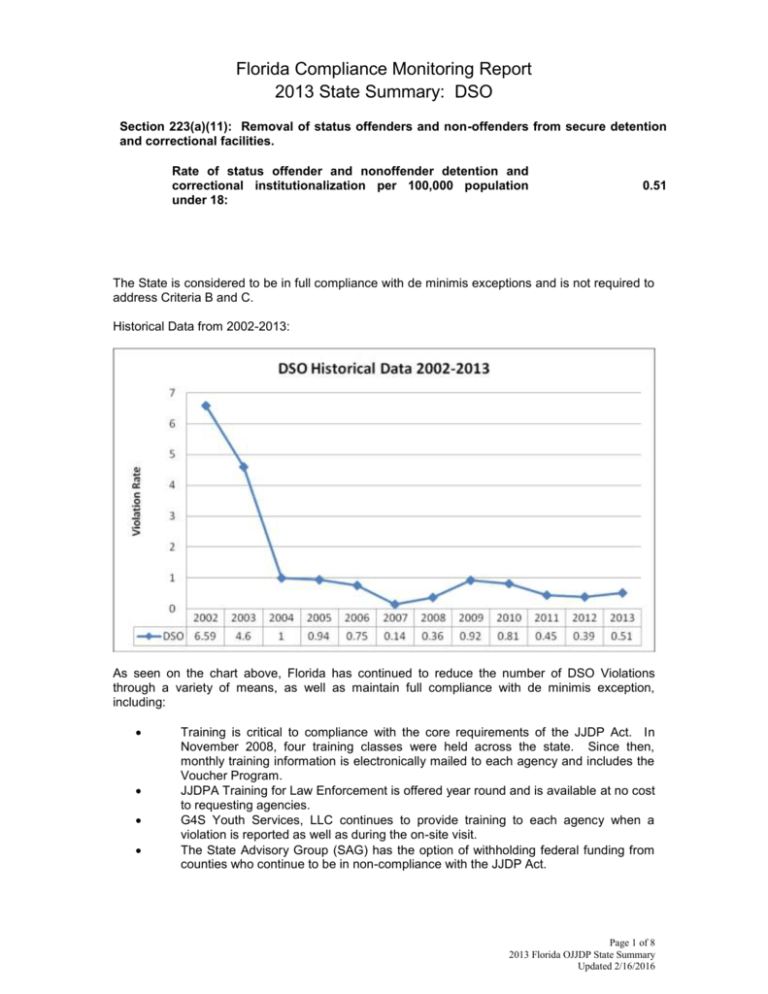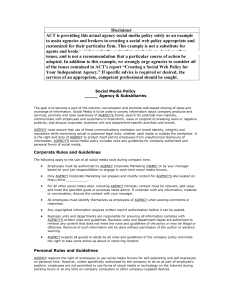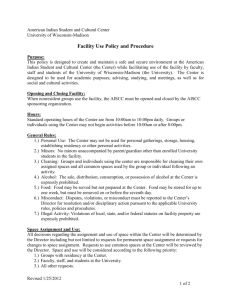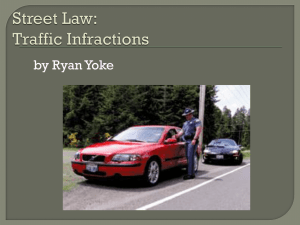Florida Compliance Monitoring Report
advertisement

Florida Compliance Monitoring Report 2013 State Summary: DSO Section 223(a)(11): Removal of status offenders and non-offenders from secure detention and correctional facilities. Rate of status offender and nonoffender detention and correctional institutionalization per 100,000 population under 18: 0.51 The State is considered to be in full compliance with de minimis exceptions and is not required to address Criteria B and C. Historical Data from 2002-2013: As seen on the chart above, Florida has continued to reduce the number of DSO Violations through a variety of means, as well as maintain full compliance with de minimis exception, including: Training is critical to compliance with the core requirements of the JJDP Act. In November 2008, four training classes were held across the state. Since then, monthly training information is electronically mailed to each agency and includes the Voucher Program. JJDPA Training for Law Enforcement is offered year round and is available at no cost to requesting agencies. G4S Youth Services, LLC continues to provide training to each agency when a violation is reported as well as during the on-site visit. The State Advisory Group (SAG) has the option of withholding federal funding from counties who continue to be in non-compliance with the JJDP Act. Page 1 of 8 2013 Florida OJJDP State Summary Updated 2/16/2016 These have been an effective method of reducing the number of DSO violations as noted in prior JJDPA Annual Reports: 2002 rate of violations: 6.59 2003 rate of violations: 4.6 2004 rate of violations: 1.0 2005 rate of violations: 0.94 2006 rate of violations: 0.75 2007 rate of violations: 0.14 2008 rate of violations: 0.36 2009 rate of violations: 0.92 2010 rate of violations: 0.81 2011 rate of violations: 0.45 2012 rate of violations: 0.39 2013 rate of violations: 0.51 Page 2 of 8 2013 Florida OJJDP State Summary Updated 2/16/2016 Florida Compliance Monitoring Report 2013 State Summary: Separation Section 223(a)(12): Separation of Juveniles and Adults. The number of juvenile offenders and non-offenders not separated from adult criminal offenders: 3 These three (3) violations occurred at three different facilities with each reporting one (1) violation. This is evidence that the practice of not separating youth from adult offenders/inmates/trustees is not a common pattern or common statewide practice. Florida law mirrors the Federal Act requirements. All violations are violations of State law. FSS 985.115(3) allows for a law enforcement officer to deliver a child, for temporary custody not to exceed six (6) hours, to a secure booking area of a jail or other facility intended or used for the detention of adults, for the purpose of fingerprinting and photographing the child or awaiting appropriate transport to the department (FDJJ) provided no sight and sound contact between the child and adult inmates or trustees is permitted and the receiving facility has adequate staff to supervise and monitor the child’s activities at all times. Florida City Police Department reported one (1) violation of Separation due to an officer not following an internal policy regarding separating youth from adults within the secure cell block area. This cell block area only provides sight separation, as muted sound is audible through the air ducts. As identified in 2009, the agency created internal system that does not allow for a youth and an adult offender/inmate/trustee to be placed is cells within the cell block during the same time period. North Miami Beach Police Department reported one (1) violation of Separation due to five (5) individuals being detained for the same criminal behavior. One (1) of the five (5) was a youth. Once identified, the agency moved the youth out of the area where adults were being detained. New Port Richey Police Department reported one (1) violation of Separation. Further information was unable to be obtained regarding the reason for the violation. Page 3 of 8 2013 Florida OJJDP State Summary Updated 2/16/2016 Historical Data from 2002-2013: As seen on the chart above, Florida continues to strive to reduce the number of Separation Violations through a variety of means, including: Training is critical to compliance with the core requirements of the JJDP Act. In November 2008, four training classes were held across the state. Since then, monthly training information is electronically mailed to each agency and includes the Voucher Program. JJDPA Training for Law Enforcement is offered year round and is available at no cost to requesting agencies. G4S Youth Services, LLC continues to provide training to each agency when a violation is reported as well as during the on-site visit. The State Advisory Group (SAG) has the option of withholding federal funding from counties who continue to be in non-compliance with the JJDP Act. FDJJ is currently working with the Florida Department of Corrections to remove F§ 945.75 from the statutes. These have been an effective method of reducing the number of Separation violations as noted in prior JJDPA Annual Reports: 2002 violations: 523 2003 violations: 336 2004 violations: 292 2005 violations: 0 2006 violations: 4 2007 violations: 2 2008 violations: 74 2009 violations: 1 2010 violations: 0 2011 Violations: 186 2012 Violations: 0 2013 Violations: 3 Page 4 of 8 2013 Florida OJJDP State Summary Updated 2/16/2016 Florida Compliance Monitoring Report 2013 State Summary: Jail Removal Section 223(a)(13): Removal of juveniles from adult jails and lockups. Rate of jail removal violations per 100,000 population under 18: 12.16 The State does not qualify for the numerical de minimis exception. Please address a narrative describing the substantive de minimis information. Florida law mirrors the Federal Act requirements. All violations are violations of State law. FSS 985.115(3) allows for a law enforcement officer to deliver a child, for temporary custody not to exceed six (6) hours, to a secure booking area of a jail or other facility intended or used for the detention of adults, for the purpose of fingerprinting and photographing the child or awaiting appropriate transport to the department (FDJJ) provided no sight and sound contact between the child and adult inmates or trustees is permitted and the receiving facility has adequate staff to supervise and monitor the child’s activities at all times. Fifty (50) agencies have reported Jail Removal violations. In regards to the amount of youth being processed through the facility and the number of violations, there appears no common statewide pattern or practice, but indicate more isolated instances due to the reasons for the violations. Four hundred seventy-nine violations are as identified below: One hundred and ninety-four (194) violations were due to a parent/guardian arriving after the 6th hour to take custody of their youth. One hundred and twenty-nine (129) violations were due to the seriousness of the delinquent behavior and the length of time for law enforcement to conduct a thorough and complete investigation, including allowing the youth to participate in a drive around to identify the various locations of the alleged behaviors. Fifty (50) violations were due to delays by the booking agency in moving the youth out of the secure area and transporting to a juvenile only facility. Thirty-five (35) violations were due to a delay in the law enforcement agency completing the required paperwork. Twenty-eight (28) violations were due to FDJJ transport arriving after the 6th hours to take custody of the youth who scored for secure detention in a juvenile only detention facility. Eleven (11) violations were due to the Department of Children & Families arriving after the 6th hours to take custody of the dependent youth. Nine (9) were not able to be identified as to the specific reason for the delay due to the lack of paperwork at the reporting agency. Eight (8) violations were due to the need for medical clearance before the youth was released to the custody of his parent/guardian or FDJJ juvenile only detention facility. Four (4) violations were due to youth providing incorrect information regarding their age. Once identified as a juvenile, the youth was removed from the secure area within 6 hours. Three (3) violations were due to a dangerously high blood alcohol level. Florida State Law allows for an agency to securely hold a person for up to six (6) hours under this condition. Two (2) violations were due to lack of appropriate training of new officers. Two (2) violations were due to judicial orders directly secure hold until court. The remaining four (4) were due to various reasons – including one (1) staff shortage, one (1) due to youth threatening harm of law enforcement officers, one (1) had escaped custody, and one (1) in which the residential program staff were delayed in arriving at the jail to pick up the youth. Page 5 of 8 2013 Florida OJJDP State Summary Updated 2/16/2016 There were approximately 23,000 youth held securely for processing in adult jails/lockups in 2012. Four hundred and seventy-nine violations is roughly .020% and therefore there is no indication that this indicates a statewide pattern of practice. Historical Data from 2002-2013: As seen on the chart above, Florida continues to strive to reduce the number of Jail Removal Violations through a variety of means, including: In 2006, the Voucher Program was created. The Voucher Program reimburses law enforcement when an officer is called in for transportation purposes. In 2007 the program was opened to all law enforcement and is currently being utilized by agencies. Training is critical to compliance with the core requirements of the JJDP Act. In February 2014, three training classes were held in the Northern region of the state for all law enforcement agencies, and an additional two will be held later in the 2014 year for the Southern region of the state. Additionally, monthly training information is electronically mailed to each agency and includes the Voucher Program. JJDPA Training for Law Enforcement is offered year round and is available at no cost to requesting agencies. G4S Youth Services, LLC continues to provide training to each agency when a violation is reported as well as during the on-site visit. The State Advisory Group (SAG) has the option of withholding federal funding from counties who continue to be in non-compliance with the JJDP Act. FDJJ is currently working with the Florida Department of Corrections to remove F§ 945.75 from the statutes. FDJJ is, and has been, working towards reducing the number of Jail Removal violations caused by delays in picking up youth who score for secure detention status in a juvenile only detention facility. Page 6 of 8 2013 Florida OJJDP State Summary Updated 2/16/2016 These have been an effective method of reducing the number of Jail Removal violations as noted in prior JJDPA Annual Reports, as seen below: 2002 rate of violations: 17.38 2003 rate of violations: 16.92 2004 rate of violations: 8.24 2005 rate of violations: 8.98 2006 rate of violations: 10.25 2007 rate of violations: 10.90 2008 rate of violations: 11.72 2009 rate of violations: 8.48 2010 rate of violations: 7.73 2011 rate of violations: 13.54 2012 rate of violations: 8.23 2013 rate of violations: 12.16 Page 7 of 8 2013 Florida OJJDP State Summary Updated 2/16/2016 Florida Compliance Monitoring Report 2013 Collocated Facilities Marion County Sheriff’s Office Juvenile Detention Facility Martin Girls Academy Polk County Sheriff’s Office Youth Detention Facility Seminole County Sheriff’s Office Juvenile Detention Facility Page 8 of 8 2013 Florida OJJDP State Summary Updated 2/16/2016








